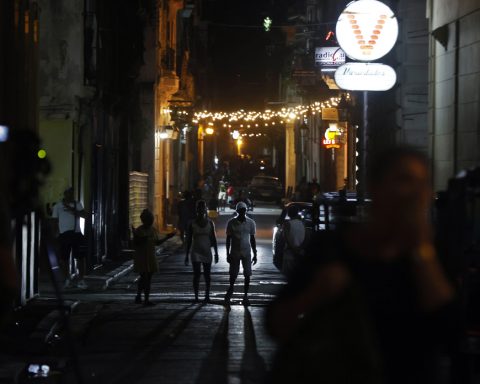SANTA CLARA, Cuba. – It is not even 8:00 in the morning and a crowd of people moves from the different districts of Santa Clara to the esplanade adjacent to the Sandino baseball stadium, the area set up for the so-called “agricultural fairs” on Sundays where They supposedly sell products at cheaper prices. The first hours of the day are ideal to be able to buy what the farmers and their intermediaries transport, just before the inspectors begin their usual tour.
From one end of the street to the other, dozens of spontaneous stalls extend, many lacking scales and others consisting of just a blanket spread on the pavement on which food, salads and the occasional seasonal fruit are displayed. On a scrap of sack, Antonio, an okra seller, organizes the vegetables inside recycled plastic pots as a standard sales measure: each cup must contain less than seven units and costs 60 pesos.
This is not a product described in the list of prices set by the local government, so you can market them depending on “supply and demand”. “They give me the bag according to the weight and I have to pay for transportation to bring it here,” the seller justifies without specifying how much profit he makes from the business. Next to Antonio, another woman has bundles of chard for sale for 50 pesos, but she actually sells them for double the retail price. “Whoever doesn’t want them should not buy them,” he responds to the reproach of a potential buyer who, although he complains about the scam, prefers to shell out the money rather than go home without the aforementioned salad.
In the busiest area of the “fair” the proposals are limited to four or five repeated products for each sales stand and with similar prices: cassava, onion in bundles, sweet potatoes and loose garlic and chili. One of them displays a sign that specifies “there is rice” as if it were an exclusive or transcendental event. People walk through the area with visible desperation, waiting for providence to lead them to some splendid discount. Putting food on the table – a reason for well-being for any mortal – represents an ordeal for those who see a month’s entire salary disappear in insignificant purchases.
“On this bag with three or four things I have spent more than 2,000 pesos and I still lack rice because I don’t even look for pork,” warns Juan Miguel López, a 62-year-old from Santa Clara who assures that he does not live solely on his salary, but thanks to the help of his daughter who lives abroad. “With everything she can send me at home, we have bread for lunch to save food.”
The high cost of food has a first-hand impact on family economic planning; The general perception agrees that a salary considered high per week is enough for less. “The normalization of massive poverty is establishing limitations on family spending,” warned recently the economist Pedro Monreal in a publication of his X account. Other data collected periodically by the newspaper 14ymedio As a reference, they indicate that inflation has certainly reached alarming levels and that the cost of living is becoming more expensive every day, even for those who receive remittances from abroad.
In one of the stalls located at the end of the esplanade, corn flour, once considered a food for humble people, is sold at the clandestine price of 100 pesos per pound. In recent weekends, beans and peas have disappeared from the market, and malanga, a food demanded by children, the elderly and the sick, is also nowhere to be found. “The beans are covered,” explains an individual who identifies himself as Yudiel. “If they catch someone selling it for more than 300 pesos, it’s a huge deal.” For several consecutive Sundays, the trade inspectors in Villa Clara have applied fines and the forced sale of merchandise to both forklift drivers and self-employed workers and to agricultural cooperatives for altering prices and weighing, withholding products, or for refusing to collect through electronic payment gateways.

From a private vehicle at the fair this Sunday, a man shouts that he has packages of chicken at the best price, more than 3,000 (the full pension of a retiree), and portions of minced meat for 300 pesos. The seller clarifies that this last product has “a problem”: “It is imported, nothing invented, but people complain that they feel little pieces of bones when they chew it.” This specific hash is for sale in almost all private markets under the name “MDM” (mixture of various mechanically deboned meats) and its price per pound varies depending on the quality of the batch. In recent months it has become the only main dish that can be accessed by the majority of Cuban families who are not able to afford a carton of eggs (at more than 3,000 pesos) or a pound of pork at more than 700 pesos.
“We are eating waste, nothing that nourishes,” protests Yolanda Sosa, a gastronomy worker in search of the weekly supply. Even so, people perceive scarcity and high prices as if they were an inevitable design to which they must obey or get used to. “Sometimes I think there are people worse than me,” says Sosa.


















